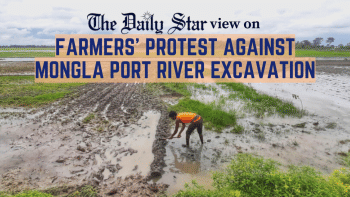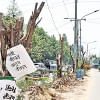River excavation must be done right

The deterioration of Mayur River, once a lifeline for Khulna residents, has happened right in front of our eyes, as has the repeated failure to revive it. Over the years, we have published a number of reports on how it is being choked by encroachments of all sorts, unregulated fish farming, ill-advised dams, and unchecked pollution, with about 26 drains pouring most of Khulna city's waste into it. Against this backdrop, the excavation projects were meant to breathe new life into the river. But instead, they have further contributed to its decline.
According to a recent report by this daily, two excavation projects taken up by the city corporation—one in 2014 and another in 2023—have failed to deliver any meaningful improvement. During a recent visit by our Khulna correspondent, the river was seen occupied by a makeshift bamboo dam, with sand being dumped at several points. Meanwhile, old problems persist as the river remains choked with silt, hyacinths, and waste, with no visible improvement in its water flow or quality. This raises serious questions about the planning and execution of such projects.
Over the years, failed or harmful excavation efforts have been reported across the country. Unfortunately, despite river dredging being routine work, the relevant authorities often do it wrong, and in isolation, without linking it up with other interventions—such as eviction, de-cluttering, and stopping other harmful and invasive activities on rivers—necessary to make its impact lasting. In Khulna alone, such cases abound.
Over the years, failed or harmful excavation efforts have been reported across the country. Unfortunately, despite river dredging being routine work, the relevant authorities often do it wrong, and in isolation, without linking it up with other interventions—such as eviction, de-cluttering, and stopping other harmful and invasive activities on rivers—necessary to make its impact lasting. In Khulna alone, such cases abound. For example, in 2022, we reported an initiative by the Mongla port authorities to dump the debris excavated from Pashur River on vast swathes of farmland, threatening soil fertility and the livelihoods of thousands. That same year, we also wrote about the Bhadra River, which, despite being excavated only two years ago, silted up again as dug-up earth fell back into it. This has been more or less the running theme of our dredging or de-siltation initiatives, with excavated debris invariably making it back to the river.
The irony here is inescapable. River excavation is supposed to solve problems like navigability, pollution, and waterlogging. Instead, it is causing them anew, or creating new ones. If we truly want to revive our dying rivers, dredging must be treated as a means, not the goal. Excavation should be preceded by proper ecological assessments, involve local communities, and include clear plans for water sourcing, encroachment removal, pollution control, and maintenance. And the relevant authorities must coordinate better and be held accountable. Otherwise, we risk repeating the same failure until our rivers are beyond saving. The Mayur River stands as a grim reminder of what such failure looks like.


 For all latest news, follow The Daily Star's Google News channel.
For all latest news, follow The Daily Star's Google News channel. 









Comments